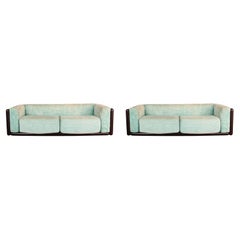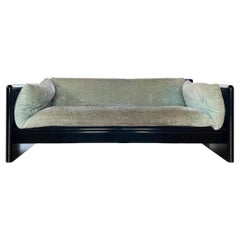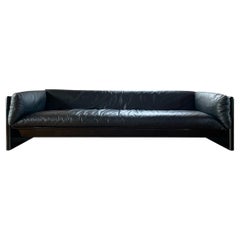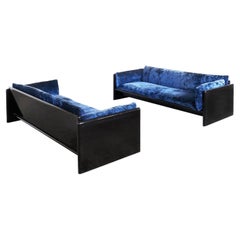Studio Simon Living Room Sets
6
to
6
6
6
6
5
6
1
5
5
Height
to
Width
to
Depth
to
4
2
5
5
5
5
4
6
6
9
60
49
40
27
Creator: Studio Simon
Carlo Scarpa Iroko Wood and Green Velvet Cornaro Sofa for Studio Simon, 1974
By Carlo Scarpa, Studio Simon
Located in Vicenza, IT
Cornaro two-seater sofa, designed by Carlo Scarpa and manufactured by Studio Simon in 1974.
Made of Iroko wood, foam, and azure chenille velvet.
Excellent vintage condition.
Born in Venice on June 2nd, 1906, Carlo Scarpa began working very early. Only a year after he had first qualified as an architect in 1926, he began working for the Murano glassmakers Cappellin & Co. in a consultative capacity; from 1927, he began to experiment with the Murano glass, and this research not only gave him excellent results here but would also inform his progress for many years to come. Between 1935 and 1937, as he entered his thirties, Carlo Scarpa accepted his first important commission, the renovation of Venice’s Cà Foscari. He adapted the spaces of this stately University building which stands on the banks of the Grand Canal, creating rooms for the Dean’s offices and a new hall for academic ceremonies; Mario Sironi and Mario De Luigi were charged with doing the restoration work on the frescos. After 1945, Carlo Scarpa was constantly busy with new commissions, including various furnishings and designs for the renovation of Venice’s Hotel Bauer and designing a tall building in Padua and a residential area in Feltre, all worth mentioning. One of his key works, despite its relatively modest diminished proportions, was the first of many works which were to follow in the nineteen fifties: the [bookshop known as the] Padiglione del Libro, which stands in Venice’s Giardini di Castello and shows clearly Scarpa’s passion for the works of Frank Lloyd Wright. In the years which were to follow, after he had met the American architect, Scarpa repeated similar experiments on other occasions, as can be seen, in particular, in the sketches he drew up in 1953 for villa Zoppas in Conegliano, which show some of his most promising work. However, this work unfortunately never came to fruition. Carlo Scarpa later created three museum layouts to prove pivotal in how twentieth-century museums were set up from then on. Between 1955 and 1957, he completed extension work on Treviso’s Gipsoteca Canoviana [the museum that houses Canova’s sculptures] in Possagno, taking a similar experimental approach to the one he used for the Venezuelan Pavilion at [Venice’s] Giardini di Castello which he was building at the same time (1954-56). In Possagno Carlo Scarpa was to create one of his most incredible ever works, which inevitably bears comparison with two other museum layouts that he was working on over the same period, those of the Galleria Nazionale di Sicilia, housed in the Palazzo Abatellis in Palermo (1953-55) and at the Castelvecchio in Verona (1957- 1974), all of which were highly acclaimed, adding to his growing fame. Two other buildings, which are beautifully arranged in spatial terms, can be added to this long list of key works that were started and, in some cases, even completed during the nineteen fifties. After winning the Olivetti Award for architecture in 1956, Scarpa began work in Venice’s Piazza San Marco on an area destined to house products made by the Industrial manufacturers Ivrea. Over the same period (1959-1963), he also worked on renovating and restoring the gardens and ground floor of the Fondazione Querini Stampalia in Venice, which many consider one of his greatest works. While he worked on-site at the Fondazione Querini Stampalia, Carlo Scarpa also began building a villa in Udine for the Veritti family. To shed some light on how much his work evolved over the years, it may be useful to compare this work with that of his very last building, villa Ottolenghi Bardolino, which was near completion at the time of his sudden death in 1978. Upon completion of villa Veritti over the next ten years, without ever letting up on his work on renovation and layouts, Scarpa accepted some highly challenging commissions which were to make the most of his formal skills, working on the Carlo Felice Theatre in Genoa as well as another theatre in Vicenza.
Towards the end of this decade, in 1969, Rina Brion commissioned Carlo Scarpa to build the Brion Mausoleum in San Vito d’Altivole (Treviso), a piece he continued to work on right up until the moment of his death. Nevertheless, even though he was totally absorbed by work on this mausoleum, plenty of other episodes can offer some insight into the final years of his career. As work on the San Vito d’Altivole Mausoleum began to lessen in 1973, Carlo Scarpa started building the new headquarters for the Banca Popolare di Verona. He drew up plans that were surprisingly different from the work he carried out simultaneously on the villa Ottolenghi. However, the plans Carlo Scarpa drew up, at different times, for a monument in Brescia’s Piazza della Loggia commemorating victims of the terrorist attack on May 28th, 1974, make a sharp contrast to the work he carried out in Verona, almost as if there is a certain hesitation after so many mannered excesses. The same Pietas that informs his designs for the Piazza Della Loggia can also be seen in the presence of the water that flows through the Brion Mausoleum, almost as if to give a concrete manifestation of pity in this twentieth-century work of art. Carlo Scarpa has put together a highly sophisticated collection of structures occupying the mausoleum’s L-shaped space stretching across both sides of the old San Vito d’Altivole cemetery. A myriad of different forms and an equally large number of different pieces, all of which are separate and yet inextricably linked to form a chain that seems to offer no promise of continuity, arising out of these are those whose only justification for being there is to bear the warning “si vis vitam, para mortem,” [if you wish to experience life prepare for death] as if to tell a tale that suggests the circle of time, joining together the commemoration of the dead with a celebration of life. At the entrance of the Brion Mausoleum stand the “propylaea,” followed by a cloister that ends by a small chapel, with an arcosolium bearing the family sarcophagi, the central pavilion, held in place on broken cast iron supports, stands over a mirror-shaped stretch of water and occupies one end of the family’s burial space. The musical sound of the walkways, teamed with the luminosity of these harmoniously blended spaces, shows how, in keeping with his strong sense of vision, Carlo Scarpa could make the most of all his many skills to come up with this truly magnificent space. As well as an outstanding commitment to architectural work, with the many projects we have already seen punctuating his career, Carlo Scarpa also made many equally important forays into the world of applied arts. Between 1926 and 1931, he worked for the Murano glassmakers Cappellin, later taking what he had learned with him when he went to work for the glassmakers Venini from 1933 until the 1950s. The story of how he came to work on furniture design is different, however, and began with the furniture he designed to replace lost furnishings during his renovation of Cà Foscari. The later mass-produced furniture started differently, given that many pieces were originally one-off designs “made to measure.” Industrial manufacturing using these designs as prototypes came into being thanks to the continuity afforded him by Dino Gavina, who, as well as this, also invited Carlo Scarpa to become president of the company Gavina SpA, later to become SIMON, a company Gavina founded eight years on, in partnership with Maria Simoncini (whose own name accounts for the choice of company name). Carlo Scarpa and Gavina forged a strong bond in 1968 as they began to put various models of his into production for Simon, such as the “Doge” table, which also formed the basis for the “Sarpi” and “Florian” tables. In the early seventies, other tables that followed included “Valmarana,” “Quatour,” and “Orseolo.” While in 1974, they added a couch and armchair, “Cornaro,” to the collection and the “Toledo” bed...
Category
1970s Italian Mid-Century Modern Vintage Studio Simon Living Room Sets
Materials
Velvet, Foam, Chenille, Wood
Carlo Scarpa Iroko and Velvet Cornaro Sofa for Studio Simon, 1974, Set of 2
By Carlo Scarpa, Studio Simon
Located in Vicenza, IT
Set of 2 Cornaro two-seater sofas, designed by Carlo Scarpa and manufactured by Studio Simon in 1974.
Made of Iroko wood, foam, and azure chenille velvet.
Excellent vintage conditi...
Category
1970s Italian Mid-Century Modern Vintage Studio Simon Living Room Sets
Materials
Chenille, Velvet, Foam, Wood
Studio Simon Black Wood and Azure Velvet Two-Seater “Simone” Sofa, Italy, 1975
By Studio Simon
Located in Vicenza, IT
Two-seater “Simone” sofa, designed and manufactured by Studio Simon in 1975.
The structure is made of black lacquered wood. An azure velvet big seat completes the sofa.
The min...
Category
1970s Italian Mid-Century Modern Vintage Studio Simon Living Room Sets
Materials
Cotton, Velvet, Foam
Studio Simon Minimalist Black Leather Three-Seater “Simone” Sofa, Italy, 1975
By Studio Simon
Located in Vicenza, IT
Three-seater “Simone” sofa, designed and manufactured by Studio Simon in 1975.
The structure is made of black lacquered wood. A black leather big seat completes the sofa.
The m...
Category
1970s Italian Mid-Century Modern Vintage Studio Simon Living Room Sets
Materials
Leather, Beech, Foam
Kazuhide Takahama White Velvet “Mantilla” Two-Seater Sofa for Studio Simon, 1973
By Kazuhide Takahama, Studio Simon
Located in Vicenza, IT
Two-seater “Mantilla” sofa, designed by Kazuhide Takahama for Studio Simon in 1973.
It is made of wood and polyurethane foam structure, with white velvet upholstery.
Kazuhide T...
Category
1970s Italian Mid-Century Modern Vintage Studio Simon Living Room Sets
Materials
Cotton, Velvet, Foam
Dino Gavina Pair of Blue Velvet 'Simone' Sofas for Studio Simon, 1971
By Studio Simon, Dino Gavina
Located in Tilburg, NL
Dino Gavina (1922-2007) rare pair of blue velvet 'Simone' sofas for Studio Simon 1971. Black lacquered high gloss wooden frame and blue velvet upholstery.
Striking pair of sofas ...
Category
Mid-20th Century Italian Post-Modern Studio Simon Living Room Sets
Materials
Fabric, Velvet, Wood, Lacquer
Related Items
Mid-Century Modern French Three-Seat Sofa by Gérard Guermonprez, 1970s
By Gerard Guermonprez
Located in Prato, IT
Mid-Century Modern French three-seat sofa with original velvet fabric designed by Gérard Guermonprez.
The sofa presents some wear consistent with age and use.
It can become a set ...
Category
1970s French Mid-Century Modern Vintage Studio Simon Living Room Sets
Materials
Chrome
H 25.2 in W 96.46 in D 35.44 in
Vintage Minimalist German Black Leather & Chrome Modular Sofa from Klöber
By Klöber
Located in Warszawa, Mazowieckie
This modular sofa was produced by Klöber, a German manufactory founded in 1935. It consists of four separate lounge chairs in black leather. The minimalist base is made from chrome-p...
Category
1980s German Minimalist Vintage Studio Simon Living Room Sets
Materials
Steel, Chrome
H 30.32 in W 31.5 in D 24.41 in
Mid-Century Modern Italian Three-Seat "Coronado" Sofa by Tobia Scarpa for B&B
By B&B Italia, Tobia Scarpa
Located in Prato, IT
Mid-Century Modern Italian three-seat flamingo pink velvet "Coronado" sofa by Tobia Scarpa for B&B. Project from 1960s
The sofa can come as a living room set together with its pair ...
Category
1970s Italian Mid-Century Modern Vintage Studio Simon Living Room Sets
Materials
Velvet, Wood
H 29.93 in W 84.65 in D 35.44 in
Kaare Klint Three-Seat Sofa for Rud. Rasmussen
By Kaare Klint, Rud Rasmussen
Located in Copenhagen, DK
Kaare Klint. A three-seat sofa with mahogany legs, seat, sides and back with blue-, red- and whitestriped Greek Savak. Executed by Rud. Rasmussen, Copenhagen.
Category
Mid-20th Century Danish Scandinavian Modern Studio Simon Living Room Sets
Materials
Mahogany, Wool
Lovely Hand Dyed Brown Leather Edwardian Style Studded Three Seat Sofa Part Set
Located in GB
We are delighted to offer for sale this lovely hand dyed tan brown leather three seat sofa with ornate stud work all over
The sofa is well made and stylish, the leather is fully a...
Category
20th Century English Edwardian Studio Simon Living Room Sets
Materials
Leather
H 34.65 in W 79.53 in D 35.04 in
Early Year LC2 Black Leather Three-Seat Sofa by Le Corbusier for Cassina, Signed
By Le Corbusier, Pierre Jeanneret, Cassina, Charlotte Perriand
Located in Los Angeles, CA
This incredibly comfortable Le Corbusier for Cassina 'LC2' three-seat sofa (authentic signed and earlier year production example with low number production number stamped on the fram...
Category
1970s Italian Bauhaus Vintage Studio Simon Living Room Sets
Materials
Steel
H 27.25 in W 71 in D 27.25 in
Three-Seat Sofa Attributed to Franco Albini, 1940s
By Franco Albini
Located in Milano, IT
Beautiful three-seat sofa from 1940 attributed to Franco Albini in rosewood.
The fabric used for the padding of the sofa Franco Albini is original of t...
Category
1940s Italian Mid-Century Modern Vintage Studio Simon Living Room Sets
Materials
Fabric, Walnut
Mario Bellini "Le Bambole" Sofa for B&B Italia, Faux-Fur, 1971, Set of 2
By B&B Italia, Mario Bellini
Located in Lonigo, Veneto
Mario Bellini “Le Bambole” two-seater sofa for B&B Italia, Mongolian faux-fur, Italy, 1971, set of two.
This is a timeless Postmodern design icon. The starting point was a shopping ...
Category
1970s Italian Mid-Century Modern Vintage Studio Simon Living Room Sets
Materials
Iron
H 29.53 in W 63 in D 33.47 in
Sofa "Simone" 3 seater Studio Simon by Gavina glossy black lacquered
By Studio Simon, Gavina
Located in Milano, MI
Elegant "Simone" Sofa Designed by Dino Gavina for Studio Simon in the 1970s.
The black glossy lacquered wood frame allows it to be placed in the center of the room having a very eleg...
Category
Mid-20th Century Italian Mid-Century Modern Studio Simon Living Room Sets
Materials
Velvet, Wood
H 22.05 in W 82.68 in D 31.89 in
Afra & Tobia Scarpa “Soriana” Sofa for Cassina, Bouclé Wool, 1969
By Cassina, Afra & Tobia Scarpa
Located in Lonigo, Veneto
Afra & Tobia Scarpa “Soriana” three-seater for Cassina, bouclé wool and chromed steel, Italy, 1969.
Although technically designed in the 1960s, the "Soriana" model by the Italian duo Tobia and Afra Scarpa is firmly associated with the next decade, when its popularity peaked. "Soriana" is low and invites you to sink into its curves. Its most notable feature, however, is the Minimalist structure in chromed steel. This external structure in steel rod keeps the cover taut using buttons...
Category
1960s Italian Mid-Century Modern Vintage Studio Simon Living Room Sets
Materials
Chrome
Smeraldo Italian Three-Seat Sofa with Carved Feet in Velvet & Satin by Zanaboni
By Zanaboni
Located in MEDA, IT
The Smeraldo sofa is a seat of modern classicism, designed to
live comfortly and elegantly the living room space. Stately model
characterized by the harmonious design of the back, th...
Category
21st Century and Contemporary Italian Art Deco Studio Simon Living Room Sets
Materials
Upholstery
H 37.01 in W 94.49 in D 51.19 in
4-Seater Sofa Gray Leather with Silk and Leather Cushions, Sormani Italy, 1980s
By Luigi Sormani and Casabella Design Miami, Sormani
Located in Arosio, IT
This four-seater, designed in the early 1980s by Luigi Sormani and Casabella Miami for a line of maxi-furniture destined to the United States is a comfortable one-block sofa for a luxury villa. The structure is in a warm gray leather and the fabric was especially made for this series called "Intrigue": a special very light grey silk fabric interwoven with burgundy leather threads. All cushions have grey leather inlays, entirely hand sewn. Julio Iglesias...
Category
1980s Italian Minimalist Vintage Studio Simon Living Room Sets
Materials
Leather, Fabric
H 28.35 in W 118.12 in D 35.44 in
Previously Available Items
Dino Gavina Pair of Blue Velvet 'Simone' Sofas for Studio Simon, 1971
By Studio Simon, Dino Gavina
Located in Tilburg, NL
Dino Gavina (1922-2007) rare pair of blue velvet 'Simone' sofas for Studio Simon 1971. Black lacquered high gloss wooden frame and blue velvet upholstery.
Striking pair of sofas ...
Category
Mid-20th Century Italian Post-Modern Studio Simon Living Room Sets
Materials
Fabric, Velvet, Wood, Lacquer
H 22.45 in W 84.26 in D 31.5 in
Studio Simon living room sets for sale on 1stDibs.
Studio Simon living room sets are available for sale on 1stDibs. These distinctive items are frequently made of velvet and are designed with extraordinary care. There are many options to choose from in our collection of Studio Simon living room sets, although brown editions of this piece are particularly popular. Many of the original living room sets by Studio Simon were created in the mid-century modern style in italy during the 20th century. If you’re looking for additional options, many customers also consider living room sets by Tito Agnoli, Mario Marenco, and Arflex. Prices for Studio Simon living room sets can differ depending upon size, time period and other attributes — on 1stDibs, these items begin at $4,450 and can go as high as $40,049, while a piece like these, on average, fetch $9,350.







